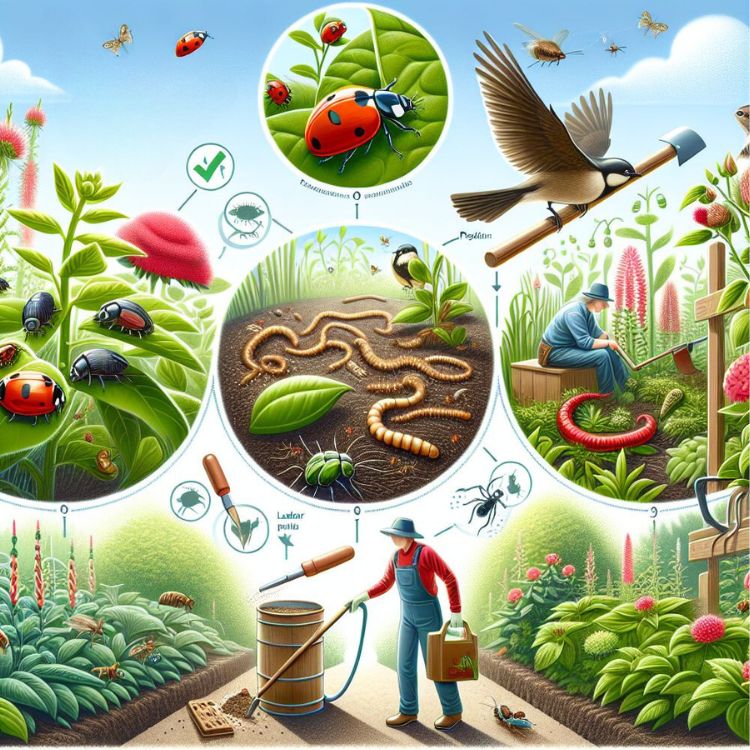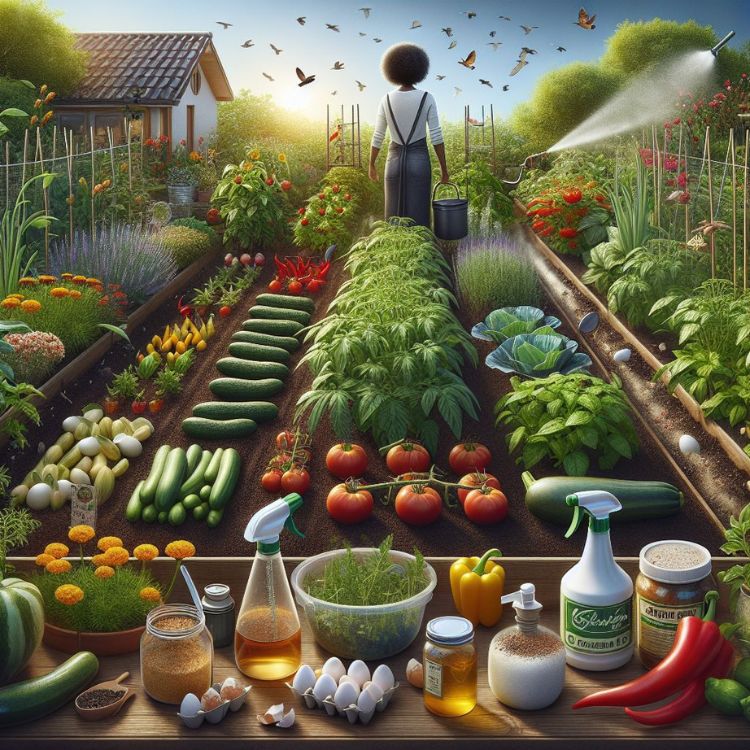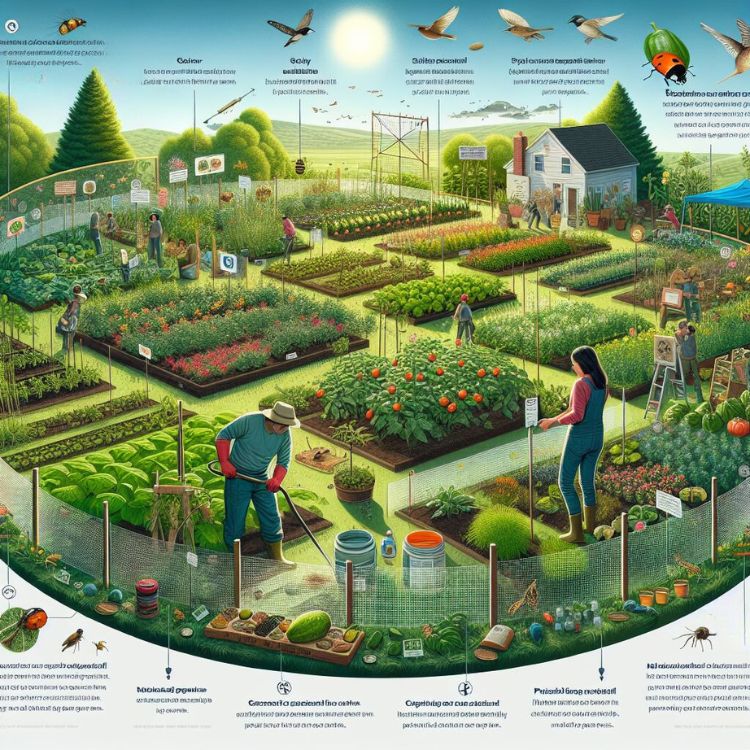
For survival gardeners, there’s a foe that threatens the thriving plants you’ve tenderly nurtured from seedlings to fruit-bearing beauties – pests. Those tiny intruders can wreak havoc on your green sanctuary, leaving a trail of destruction that affects both yield and plant health. However, fear not, because mastering survival garden pest control is entirely within your grasp! From understanding pest behaviors to employing safe and sustainable control methods, let’s unlock the secrets of creating a resilient, pest-free survival garden.
Key Takeaways
- Effective pest control in survival gardening involves understanding pest behaviors and employing safe and sustainable methods.
- Common garden pests pose specific threats that can be managed through early detection and targeted action.
- Employing winning tactics such as using beneficial bugs, DIY repellents and traps, and chemical-free pesticides can help maintain a pest-free survival garden.
- Proactive pest prevention through strategies like companion planting, crop rotation, and diversity aids in long-term pest control.
- Maintaining a regular gardener’s routine and observing good garden hygiene are vital for deterring pests and keeping your survival garden healthy.
- Homemade pesticides and everyday items can serve as effective and safe pest control agents.
- A pest-free survival garden requires knowledge, vigilance, and a proactive approach but yields a resilient, nutritious supply of homegrown produce.
Unlocking the Secrets of Survival Garden Pest Control

Incorporating integrated pest management techniques is essential for maintaining a healthy garden ecosystem. This approach involves using a combination of cultural, mechanical, biological, and chemical control methods to keep pests at bay while minimizing harm to beneficial insects and the environment. By practicing crop rotation, companion planting, and maintaining proper soil health, you can create a less attractive environment for pests and promote the growth of resilient plants that can better withstand potential attacks.
Additionally, staying vigilant and regularly monitoring your garden for any signs of pest infestation is key to addressing issues before they escalate. Implementing physical barriers, such as row covers or fencing, can also help protect your plants from larger pests like rabbits or deer. By staying proactive and adapting your strategies based on the specific pests present in your area, you can cultivate a thriving garden that is not only beautiful but also abundant in produce. Remember, patience and perseverance are crucial in the ongoing battle against pests in your survival garden.
Your Blueprint to a Pest-Free Garden
There are several strategies for effective pest control in your survival garden. These range from natural remedies like predator plants and homemade pesticides to best practices like crop rotation and diligent garden inspections. Embracing a proactive approach is key, as preventative action often trumps reactive measures when it comes to pest management.
Decoding Pest Behaviors and Weaknesses
Pests, like all creatures, have their unique behaviors and vulnerabilities. Understanding their life cycle, feeding habits, and preferred environments can provide invaluable insight into managing them effectively. By targeting their weaknesses and disrupting their life cycle, you can keep your survival garden free from harmful pests.
Know Your Enemies: Common Pests and Their Impact

Gardeners must be vigilant in identifying and understanding the common pests that can wreak havoc on their plants. Aphids are notorious for their ability to quickly reproduce and infest plants, causing damage by sucking the sap from leaves and stems. These tiny insects can weaken plants and transmit diseases, making them a significant threat to a variety of garden crops. On the other hand, snails and slugs are known for their voracious appetite for leafy greens, leaving behind ragged edges on leaves as they feed. These slimy pests can decimate entire crops if left unchecked, making them a major concern for many gardeners.
Armed with knowledge about these common pests, gardeners can develop effective control strategies to protect their plants. By implementing integrated pest management techniques, such as attracting natural predators or using organic pesticides, gardeners can reduce pest populations without harming beneficial insects or the environment. Additionally, practicing good garden hygiene, such as removing debris and weeds that can harbor pests, can help prevent infestations from taking hold. By staying informed and proactive in pest management practices, gardeners can ensure a healthy and thriving garden for years to come.
Identifying Garden Foes: From Aphids to Slugs
Being able to identify common garden pests is crucial in managing them. Whether it’s the tiny, green aphids on your roses or the slimy slugs on your lettuce, understanding their characteristics helps you recognize their presence early and take appropriate action.
Damage Diagnostics: How Pests Affect Your Plants
Pests can inflict various types of damage on your plants, from chewed leaves and scarred fruits to stunted growth or even plant death. Recognizing the signs and symptoms of pest damage is essential for diagnosing pest problems and deciding on the best course of action.
Winning Tactics: Safe and Sustainable Control Methods
Implementing safe and sustainable control methods in your garden not only protects your plants from pests but also contributes to the overall health of the environment. By opting for eco-friendly solutions such as using natural predators, creating habitats for beneficial insects, and practicing crop rotation, you can effectively manage pest populations without causing harm to the ecosystem. These methods work in harmony with nature, promoting a balanced and thriving garden that can resist pest infestations naturally.
Furthermore, embracing safe and sustainable control methods in your gardening practices can lead to long-term success and reduced reliance on harmful chemicals. Chemical pesticides may provide a quick fix, but they can also disrupt the delicate balance of your garden ecosystem and harm beneficial insects, pollinators, and other wildlife. By choosing safe alternatives, you not only protect the health of your plants but also contribute to the preservation of biodiversity and the overall well-being of the environment. Ultimately, adopting these winning tactics ensures a healthy and sustainable garden that can flourish for years to come.
Natural Allies: Beneficial Bugs and Predator Plants
Believe it or not, not all bugs are foes; some are allies in your battle against pests. From ladybugs that devour aphids to predator plants like pitcher plants that trap insects, these natural allies play a crucial role in maintaining a pest-free garden.
The Warrior’s Tools: DIY Pest Repellents and Traps
Armed with simple tools from your kitchen, you can create effective DIY pest repellents and traps. From vinegar traps for fruit flies to chili spray for various insects, these homemade solutions are safe, affordable, and surprisingly effective!
Timing is Key: Best Practices for Proactive Pest Prevention
Proactive pest prevention requires impeccable timing. Knowing when pests are most active and vulnerable allows you to disrupt their life cycle effectively and reduce their population in your garden.
The Stealth Approach: Chemical-Free Pesticides

Chemical-free pesticides are increasingly becoming popular due to their environmentally friendly nature. Unlike traditional pesticides that can harm beneficial insects and contaminate the soil, chemical-free options provide a safer alternative for pest control. By utilizing natural ingredients such as essential oils, neem oil, or diatomaceous earth, these pesticides effectively target pests while minimizing any adverse effects on the ecosystem. This stealth approach not only protects your plants but also ensures the well-being of other beneficial bugs that play a crucial role in maintaining a balanced and healthy garden.
Furthermore, chemical-free pesticides offer a sustainable solution for pest management in agricultural practices. By reducing the reliance on synthetic chemicals, farmers can protect the long-term health of their soil and crops. These natural alternatives are also beneficial for human health, as they eliminate the risk of exposure to harmful residues found in conventional pesticides. Embracing chemical-free pesticides is not only a responsible choice for sustainable agriculture but also a step towards creating a more eco-friendly and harmonious environment for both plants and people.
Brewing Up Garden Guardians: Homemade Pesticides
With just a few household ingredients, you can brew your own homemade pesticides. These easy-to-make concoctions can effectively deter pests while preserving the health and vitality of your garden
From Kitchen to Garden: Everyday Items as Pest Control Agents
Common household items can serve as effective pest control agents. From garlic and coffee grounds to dish soap and baking soda, these everyday items can help you wage war on pests.
Going Organic: Long-Term Sustainable Strategies
In the realm of survival gardening, opting for organic and sustainable strategies is crucial for long-term success. By cultivating a garden that thrives on natural practices and products, you not only safeguard the health of the environment but also ensure the longevity of your food production. Organic pest management methods, such as companion planting, crop rotation, and beneficial insect attraction, play a significant role in maintaining a balanced ecosystem within your garden. These practices not only deter pests naturally but also promote biodiversity and soil health, contributing to the overall resilience of your garden against potential threats.
Furthermore, embracing organic and sustainable practices in survival gardening not only benefits the immediate environment but also fosters a deeper connection with nature. By choosing to work in harmony with the natural world rather than against it, you become a steward of the land, nurturing it for future generations. As you witness the positive impact of your efforts on the health and productivity of your garden, you may find a renewed sense of appreciation for the intricate web of life that sustains us all. Ultimately, by going organic and prioritizing long-term sustainability in your gardening endeavors, you are not just growing food – you are cultivating a relationship with the earth that is grounded in respect and reciprocity.
Companion Planting: Nature’s Own Pest Management
Companion planting leverages the natural affinities between plants to deter pests. Certain plant combinations can help repel pests, attract beneficial bugs, or even enhance each other’s growth.
Crop Rotation and Diversity: A Double-Edged Sword Against Pests
Crop rotation and diversity are potent tools in your pest control arsenal. By rotating crops and cultivating a diverse range of plants, you can disrupt pest cycles and prevent any single pest from taking over your garden.
The Gardener’s Routine: Daily Steps to Deter Pests

One of the key aspects of a successful gardener’s routine is regular watering. Proper hydration not only keeps your plants healthy and thriving, but it also helps deter pests. Many insects are attracted to dry, weakened plants, so by maintaining consistent watering practices, you can help prevent pest infestations. Additionally, a well-hydrated garden is less susceptible to diseases that can also attract pests.
In addition to watering, weeding and pruning are essential steps in the gardener’s routine to deter pests. Weeds can provide shelter and food sources for pests, so keeping your garden clear of them can help reduce the likelihood of infestations. Pruning helps improve air circulation and sunlight exposure, creating an environment that is less favorable for pests to thrive. Finally, regularly observing your plants for any signs of pest damage is crucial in identifying and addressing issues early on. By taking these daily steps to deter pests, you can maintain a healthy and thriving garden all season long.
Inspection Rituals: Daily Garden Walk-Through Tips
A daily walk-through of your garden not only helps you enjoy the fruits of your labor but also enables you to spot early signs of pest infestation. Early detection is key to effective pest control and helps minimize damage to your plants.
Garden Hygiene: Cultural Practices That Deter Pests
Keeping your garden clean is not just about aesthetics; it’s a cultural practice that significantly deters pests. By removing plant debris, fallen fruits, and diseased plants, you can reduce the habitat and breeding grounds for pests.
FAQs: Your Questions Answered
What is the Most Effective Natural Pesticide?
The most effective natural pesticide is neem oil. Neem oil is derived from the seeds of the neem tree, which is native to India. It works by disrupting the life cycle of pests, such as insects, mites, and fungi, by interfering with their feeding and reproductive activities. Neem oil is safe to use on a variety of plants and crops, as it is non-toxic to humans and animals. It is also environmentally friendly, as it breaks down quickly and does not harm beneficial insects, such as bees and ladybugs. Neem oil can be used as a foliar spray or soil drench to control a wide range of pests, making it one of the most effective natural pesticides available.
Another highly effective natural pesticide is diatomaceous earth. Diatomaceous earth is made from the fossilized remains of tiny aquatic organisms called diatoms. It works by physically damaging the exoskeletons of insects and other pests, causing them to dehydrate and die. Diatomaceous earth is safe to use around pets and humans but should be applied carefully to avoid inhaling the fine particles. It can be used indoors and outdoors to control pests like ants, fleas, bed bugs, and cockroaches. Diatomaceous earth is a long-lasting solution for pest control and is a popular choice among organic gardeners for its effectiveness and safety.
How Can I Attract Beneficial Insects to My Garden?
Attracting beneficial insects to your garden can help naturally control pests and promote a healthy ecosystem. One way to attract beneficial insects is by planting a diverse range of flowers, herbs, and other plants that provide nectar, pollen, and shelter for these insects. For example, plants such as marigolds, dill, fennel, and sunflowers are known to attract beneficial insects like ladybugs, lacewings, and bees.
Another way to attract beneficial insects is by creating habitats that provide shelter and breeding areas for these insects. This can include leaving some areas of your garden undisturbed for nesting sites, providing water sources like bird baths or shallow dishes with rocks for insects to drink from, and incorporating features like insect hotels or rock piles for additional shelter. By creating a welcoming environment for beneficial insects, you can help balance the ecosystem in your garden and reduce the need for chemical pesticides.
Is it Too Late to Control Pests Once They’re in My Garden?
It is not necessarily too late to control pests once they have invaded your garden, but the effectiveness of your pest control efforts may vary depending on the extent of the infestation. There are several methods you can employ to manage pests in your garden, including using organic pesticides, introducing beneficial insects, practicing crop rotation, and hand-picking pests. It is important to regularly monitor your plants for signs of pest damage and take action promptly to prevent the infestation from worsening.
In addition to implementing pest control measures, it is also essential to practice good gardening practices that can help prevent future pest problems. This includes maintaining healthy soil, providing proper watering and fertilization, and promoting biodiversity in your garden. By creating a balanced ecosystem in your garden, you can naturally reduce the likelihood of pests taking over and ensure the long-term health of your plants. Remember that pest control is an ongoing process, and staying vigilant and proactive is key to keeping your garden thriving.
Can Companion Planting Actually Repel Pests?
Companion planting is a gardening technique where different plants are grown together to provide benefits such as pest control, pollination, and improved growth. One of the most intriguing aspects of companion planting is its ability to repel pests naturally. Certain plants emit compounds or scents that can deter pests from attacking nearby plants. For example, marigolds are known for their ability to repel nematodes in the soil, while garlic and chives can help deter aphids and beetles.
While companion planting can be effective in repelling pests, it is important to note that it is not a foolproof solution and may not work for every pest problem. Factors such as plant selection, placement, and environmental conditions can all impact the success of companion planting for pest control. It is also important to consider the specific pests you are dealing with and research which companion plants are known to deter them. Overall, incorporating companion planting as part of a holistic pest management strategy can help reduce the need for chemical pesticides and create a more diverse and resilient garden ecosystem.
What Are Some Signs of Pest Infestation to Look Out For?
Some signs of pest infestation to look out for include:
- Physical damage: This can manifest as gnaw marks on furniture or walls, shredded fabric, or holes in food packaging. Rodents like mice and rats are known for causing this type of damage.
- Droppings: Pest droppings are a clear indicator of an infestation. The size and shape of the droppings can give clues about the type of pest present in your home. For example, rodent droppings are usually small and cylindrical, while cockroach droppings resemble coffee grounds.
It is important to stay vigilant and address any signs of pest infestation promptly to prevent further damage to your property and ensure the health and safety of your household. Regularly inspecting your home for these signs can help you catch pest problems early on and take appropriate measures to control them.
Conclusion
Mastering survival garden pest control is no small feat, but with knowledge, vigilance, and a proactive approach, you can protect your hard-earned produce from pesky invaders. Implement these safe and sustainable strategies to create a resilient, thriving survival garden that nourishes your body and soul even in challenging times.
As you embark on this journey of cultivating a pest-free survival garden, remember that you don’t have to go it alone. We at Survival Essentials are committed to providing you with top-quality seeds and invaluable resources for your gardening journey.
Ready to start or expand your survival garden? Visit Survival Essentials for a curated collection of top-tier survival seeds that will not only thrive in your garden but also provide bountiful harvests for you and your loved ones.






